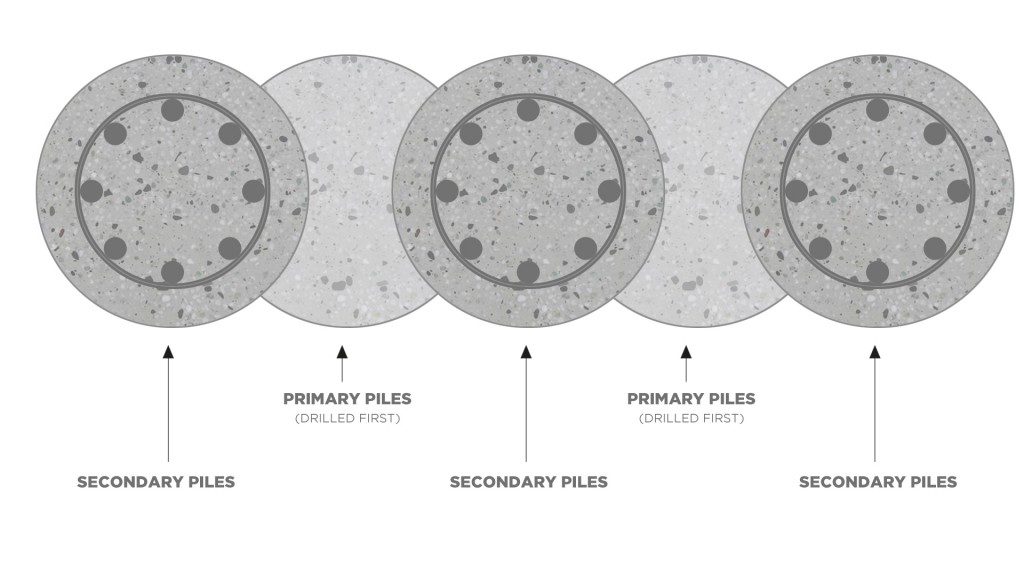Pile wall
Piles are circular structural elements executed in the ground for the purpose of transferring vertical and horizontal loads into deeper and better layers of the foundation soil.
Executing piles in the near vicinity, a pilot wall is formed and it is used as a temporary or permanent retaining structure in soil mass. Pile wall is applied to ensure stability of excavation, open pits sealing, buildings displacement control and landslide remediation.

Depending on geotechnical characteristics of the location and project requirements, we differentiate several types of pile wall.
According to the type of resistance, the pile wall is divided into a cantilever or a supported structure. According to the pile layout the pile wall is divided into a secant/tangent or contiguous pile wall.
Cantilever pile wall
Cantilever pile wall represents a retaining structure performed without additional protection. The wall is executed by digging under the level of excavation / slide surface and stabilises the soil mass due to the resistance of material in the front.
Performance advantages:
- undisturbed excavation in the open pit
- does not require support installation that may pass below adjacent parcels
- simpler construction procedure due to simpler stages of construction

Supported pile wall
Supported pile wall represents retains structure which is executed with additional protection when it is not possible to ensure the stability of the structure for design loads.
Depending of design requirements, additional pile wall protection can be performed inside (bracing system) and outside of open pit (geotechnical and self drilling anchors etc.) On front of side pile wall, on the position of additional protection, steel or reinforced concrete horizontal and / vertical beams are commonly used for the purpose of load transfer from protection measures to the pile wall.
Performance advantages:
- possibility of deeper depth of excavation compared to the cantilever pile wal
- possibility of accepting more loads (eg in existing building area)
- more control of pile wall horizontal displacement

Contiguous pile wall
Contiguous pile wall is executed with a spacing between piles. Such pile wall is mainly applied in coherent (fine-grained) materials where there is no possibility of material collapse between the piles. If it is necessary, the shotcrete layer can be installed on the pile wall to stabilize the material.
Performance advantages:
- quicker, cheaper and simplier performance compared to other types of pile wal
- adaptability in execution phase

Secant or tangent pile wall
Secant pile wall is formed by executing intersecting reinforced concrete pile. First phase includes executing of primary piles who are executed without reinforcement.
After installation of concrete and achieving the appropriate strength, the execution of secondary pile is performed by drilling through the foundation soil and partly through the primary pile. The primary and secondary pile overlap typically of 8 to 10 cm. After the drilling is completed, the piles are reinforced with steel bors or profiles and concrete is installed.
Tangent pile wall consists of piles that touch but do not overlap. Consequently, all piles of tangential pile wall must be reinforced.
Performance advantages:
- larger stiffness and ability to accept higher loads and bigger depth of open pit
- possible execution and control of excavation in non-cohessive materials where there is a possibility of collapsing materials between the piles
- possibility of open pit sealing in the secant pile wall (for the purpose of securing the sealing, the shortcrete layers can be installed)


